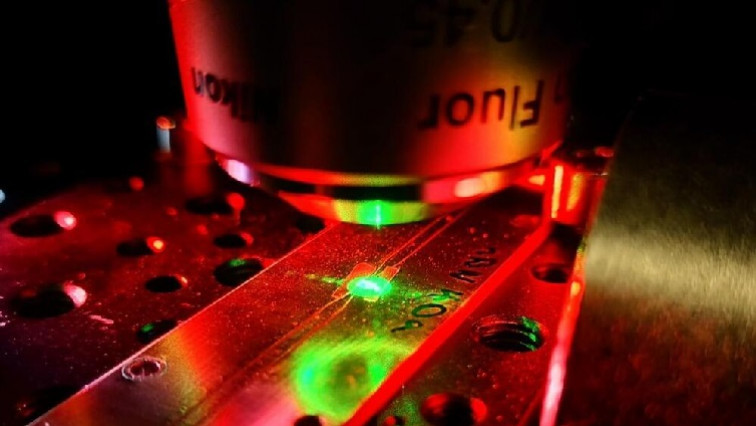To date, quantum sensing chips have been made from diamond as it’s a very robust platform. The limitations of diamond-based sensors, though, is that they can only detect magnetic fields when aligned in the direction of the field. If unaligned, they have large blind spots. As a result, magnetometers made of diamond must contain multiple sensors at varying degrees of alignment. This increases the difficulty of operation and, as a result, the versatility to use in different applications. In addition, the rigid and three-dimensional nature of the quantum sensor means that its ability to get close to samples that aren’t perfectly smooth is restricted.
TMOS Associate Investigator Jean-Philippe Tetienne (RMIT University) and Chief Investigator Igor Aharonovich (University of Technology Sydney) and their teams are pioneering a new quantum sensing platform using hBN. These hBN crystals are made up of layers of atomically thick sheets and are flexible, which allows the sensing chips to conform to the shape of the sample being studied, getting far closer to the sample than diamond can.
Different defects exist in the hBN that produce different optical phenomena. A recently discovered carbon-based defect, the atomic structure of which remains unidentified, detects magnetic fields in any direction but until now has not been used for magnetic imaging.
In an effort to determine the structure of the unidentified defect, the team ran a Rabi measurement experiment and compared the results with the well-understood boron vacancy defect that also exists in hBN. This boron vacancy defect can be used to measure temperature at a quantum level. Through this comparison, they discovered the new defect behaves as a spin half system. This half spin nature of the carbon defect is what allows for the sensor to detect magnetic fields in any direction.
The team determined that this new carbon-based half spin sensor could be controlled through electrical excitation, in the same way that the boron vacancy sensor can, and that they could be tuned to interact with one another. Energised by these discoveries, they set out to demonstrate a hBN sensing chip that could use both spin defects simultaneously to measure magnetic field and temperature. Their paper shows the first magnetic images ever taken with this unidentified isotropic sensor.
Cofirst author, Sam Scholten from RMIT University says, “Optically addressable spin defects in solids form a vital toolkit in the realm of quantum materials due to their potential to be utilized as nanoscale quantum sensors and more generally as robust room temperate quantum systems.
“What makes hBN unique and exciting is its 2D form, which allows our sensors to get much closer to the sample.”
Co-first author, Priya Singh from RMIT University says, “Diamond spins have been used for over a decade in biological systems as an in-situ probe. I am eager to take our hBN into the continuously moving cellular environment, where the directional independence of the sensor would be an advantage.”
TMOS Chief Investigator Igor Aharonovich says, “hbN has many advantages over diamond as a quantum light source for communications and sensing. In addition to its ultra-thin form factor, it can also operate as a quantum light source for communications at room temperature, where diamond often requires cryogenic cooling. hBN is also much cheaper and more accessible than diamond.”
Generally, these new low-dimensional materials offer the chance of discovering new physics due to their extreme anisotropy. Potential future applications for this quantum sensing technology include in-field identification of magnetic geological features. The spin half nature of the defect will also allow for radio spectroscopy across a wider band than competing technologies.
TMOS Associate Investigator Jean-Phillipe Tetienne says, “The next step for this research is to identify what the atomic defects in the hBN are. By understanding the composition of these, we can make progress toward engineering sensor devices for optimal performance.
“I am excited about exploring the properties and opportunities of this new optical spin defect. Its spin half nature is novel in our community, and there are many questions to answer.”
For more information about this research, contact connect@tmos.org.au
Multi-species optically addressable spin defects in a van der Waals material
Sam C. Scholten, Priya Singh, Alexander J. Healey, Islay O. Robertson, Galya Haim, Cheng Tan, David A. Broadway, Lan Wang, Hiroshi Abe, Takeshi Ohshima, Mehran Kianinia, Philipp Reineck, Igor Aharonovich, Jean-Philippe Tetienne
Optically addressable spin defects hosted in two-dimensional van der Waals materials represent a new frontier for quantum technologies, promising to lead to a new class of ultrathin quantum sensors and simulators. Recently, hexagonal boron nitride (hBN) has been shown to host several types of optically addressable spin defects, thus offering a unique opportunity to simultaneously address and utilise various spin species in a single material. Here we demonstrate an interplay between two separate spin species within a single hBN crystal, namely S = 1 boron vacancy defects and carbon-related electron spins. We reveal the S = ½ character of the carbon-related defect and further demonstrate room temperature coherent control and optical readout of both S = 1 and S = ½ spin species. By tuning the two spin ensembles into resonance with each other, we observe cross-relaxation indicating strong inter-species dipolar coupling. We then demonstrate magnetic imaging using the S = ½ defects and leverage their lack of intrinsic quantization axis to probe the magnetic anisotropy of a test sample. Our results establish hBN as a versatile platform for quantum technologies in a van der Waals host at room temperature.
Read the original article on TMOS.


